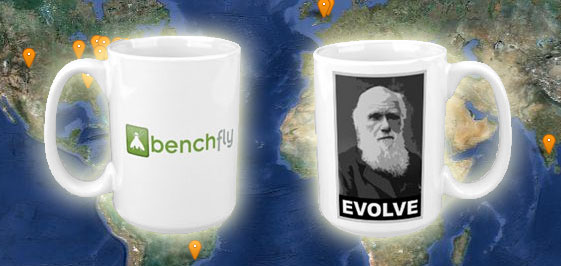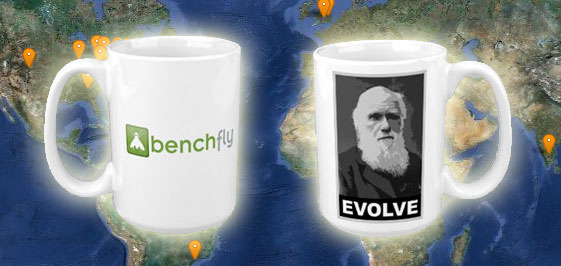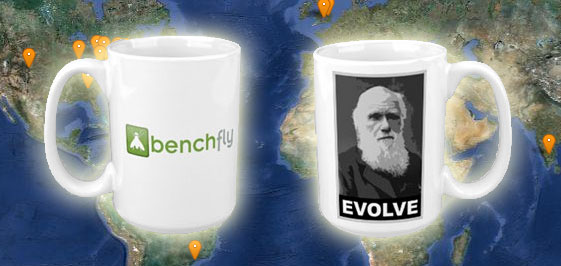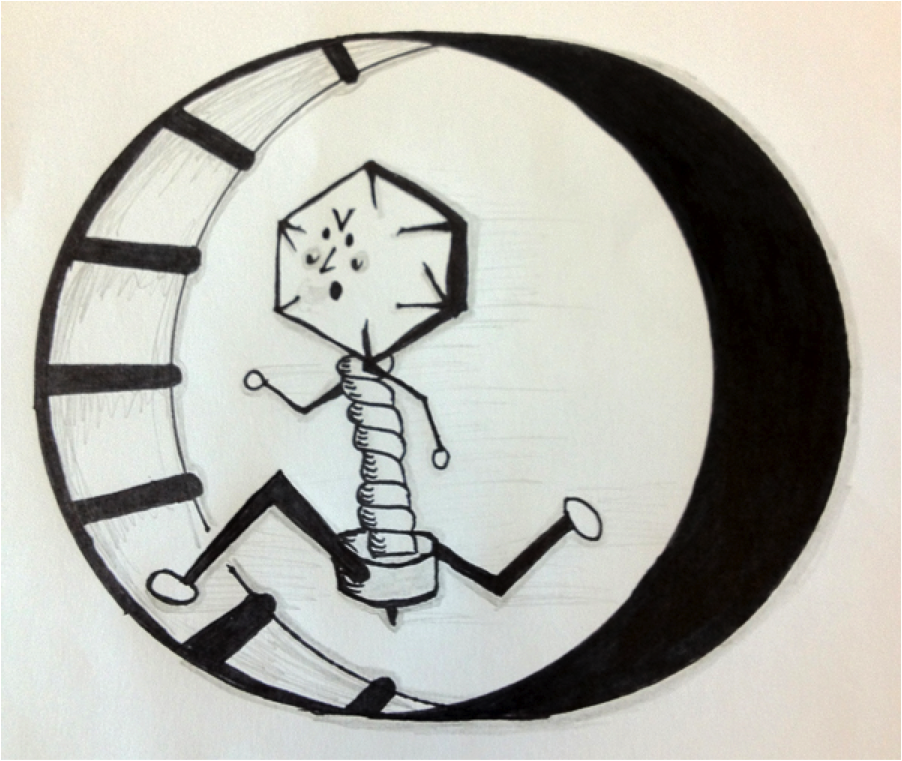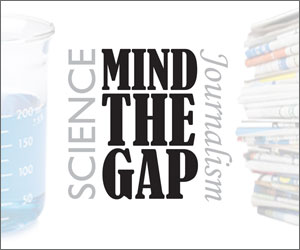 Since defending my thesis I’ve been repeatedly putting off starting the diet and exercise regime needed to lose the excess pounds I gained while writing it. Sadly, the time has come for my procrastination to end and the torture to begin, and on September 1 I will put the Insanity DVD into my computer, actually work out, and stop eating delicious things like bread and pasta and French fries. Tear.
Since defending my thesis I’ve been repeatedly putting off starting the diet and exercise regime needed to lose the excess pounds I gained while writing it. Sadly, the time has come for my procrastination to end and the torture to begin, and on September 1 I will put the Insanity DVD into my computer, actually work out, and stop eating delicious things like bread and pasta and French fries. Tear.
But what if I could just convince some of my copious amounts of white adipose tissue to become brown?
Animals have three types of fat (a.k.a. adipose tissue) composed of different types of adipocytes (fat cells). White adipose tissue is the most common, and it’s the stuff that builds up when you gain weight. It is also metabolically relatively inactive and acts as an energy store. Brown adipose tissue, on the other hand, is extremely metabolically active and is involved in maintaining body temperature through using the chemical energy found in food to generate heat. Humans only have very small amounts of brown fat, with deposits found at the back of the neck and along the spinal cord.
The third type of fat cell is the beige adipocyte. These cells are found in white adipose tissue, and appear to be the result of white fat cells taking on certain characteristics of their brown counterparts, in particular their energy burning ability, rather than representing a distinct cell type. This is particularly exciting for those of use with a bit too much white adipose tissue: What if we could coax white cells to become beige? Could we brown our white fat (“of course, not in a skillet, but directly inside the body”, joked lead author Prof. Dr. Alexander Pfeifer), burn more energy, and eat cake while loosing weight?
The conclusion of a study by German scientists published this week in Science Signaling is perhaps. Using mice, the authors found that a particular signaling pathway is involved in regulating the energy-burning potential of fat cells. The activity of a protein called vasodilator-stimulated phosphoprotein (VASP) is critical in the differentiation of fat cells, and mice lacking this protein showed increased browning of their white fat and a reduced body mass compared to their wild type litter mates. Without VASP, the knockout mice showed increased levels of cyclic GMP, a small molecule that is involved in transmitting cellular messages between proteins. Importantly, high levels of cyclic GMP are required for brown fat cell differentiation through the activity of protein kinase G. Thus, by knocking out VASP the authors were able to increase beige adipose tissue levels and rear lean mice. In normal mice, VASP acts as a negative regulator of cyclic GMP levels. The authors found that in the white adipose tissue of these animals a negative feedback loop was initiated when cyclic GMP reached a certain level through the activation of VASP.
While this pathway has, for now, only been demonstrated to work in mice, it represents a potential therapeutic target for the treatment of obesity. Cyclic GMP is a molecule involved in a number of cellular processes, so indiscriminately up-regulating its production would be dangerous. However, interfering with the VASP feedback loop in white adipocytes represents an exciting area for further research.
So it would seem that, at least for now, I’m going to have to shift the thesis weight the old fashioned way. Sigh…
Katie Pratt is a postdoc in Molecular Biology at Brown University. She has a passion for science communication, and in an attempt to bring hardcore biology and medicine to everyone, she blogs jargon-free at www.katiephd.com. Follow her escapades in the lab and online on Twitter.
.
Be the first to mind the gap by filling in the name of the protein as a comment and get your name in the blog along with a sweet new BenchFly mug!
UPDATE: Congratulations to Subhasree – this week’s winner of Mind the Gap!
About the winner: Subhasree is a third year graduate student at Texas Tech University Health Sciences Center working in Dr. Ruiwen Zhang’s lab on the p53 independent activities of the MDM2 oncogene. You can get in touch with her via Facebook or Twitter.
About the prize: In addition to fame and glory beyond their wildest dreams, winners receive our new hot-off-the-presses large (15 oz) BenchFly mug to help quench their unending thirst for scientific knowledge… or coffee. Check out where the mug has traveled – will you be the first in your state or country to win one?
Miss a previous edition of Mind the Gap? Shame on you! Don’t worry – we’ve got you covered:
- Forget Wireless Keyboards and Touch Your Plant Instead
- Coitus Interruptus
- Sun, Sand, and Damaged RNA
- Let’s Talk About (Fruit Fly) Sex
- This is Not an Article About Running Viruses
- How is a Dormouse Like a Career Scientist?
- With Great Power Comes Great Violin Strings
- Tweet Tweet? TWEEEET!!
- All the Better to See Sperm Whales With, My Dear
- Saw VII: The Revenge of the Sawfish
- Caution: Objects May Appear Larger Than They Really Are
- Facebook Updates: The Good, The Bad, and The Vague
- Scared of Dropping the Soap? Worry No More.
.
]]>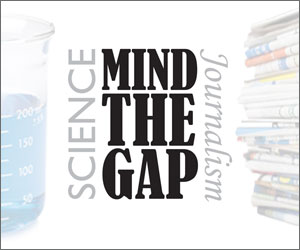 This is one of those stories that I just couldn’t ignore. In a nutshell, it’s about using plants to interface with your computer. I know, weird, right?
This is one of those stories that I just couldn’t ignore. In a nutshell, it’s about using plants to interface with your computer. I know, weird, right?
A collaborative project funded primarily by Disney Research Pittsburg (I had no idea that existed either) has developed a technology that allows you to do stuff with a computer by feeling up a potted plant. An electrode is inserted into the soil and hooked up to your CPU. Then, when you touch the plant, a signal is sent to the computer and does…well…stuff.
The scientists used machine assisted learning to teach the computer program how to understand the plant. So, for example, stroking the stem of an orchid might play a high-pitched sound or produce a red color, whereas tousling a gardenia would generate a low-pitched growl and a green glow. Alternatively, you could teach your plant to do something useful, like change the TV channel or schedule a meeting. The possibilities are endless.
But why use plants in this way? From reading the small amounts of materials that accompany the Botanicus Interacticus website, it would seem that the inventors don’t appreciate the way we currently interact with the technological world, by using touchscreens, for example, and would rather we get back in touch with nature. Indeed the emphasis of the project appears to be on the creative, with the exhibit demonstrated in this video centered on musical and colored outputs.
Perhaps the most exciting part about this is the use of different plants to generate different outputs. However, I was mildly disturbed to read “Engaging with more painful plants, such as cactuses, would provide far more rewarding experiences” (ref). I would have thought a more pleasant application would be to use scented herbs, so that in touching the plants you also generated a nice smell. Silly me.
So perhaps in the future those plants on your desk will be more than just decoration, and the fichus in the corner of your bedroom will act as your burglar alarm. Whatever the outcome, I for one will not be attaching a cactus to my alarm clock.
Katie Pratt is a postdoc in Molecular Biology at Brown University. She has a passion for science communication, and in an attempt to bring hardcore biology and medicine to everyone, she blogs jargon-free at www.katiephd.com. Follow her escapades in the lab and online on Twitter.
.
Be the first to mind the gap by filling in the primary funding organization as a comment and get your name in the blog along with a sweet new BenchFly mug!
 UPDATE: Congratulations to Allie W – winner of this week’s Mind the Gap!
UPDATE: Congratulations to Allie W – winner of this week’s Mind the Gap!
About the winner: Allie is a freelance science writer and founder of This Is What A Scientist Looks Like. Follow her on Twitter for the latest.
About the prize: In addition to fame and glory beyond their wildest dreams, winners receive our new hot-off-the-presses large (15 oz) BenchFly mug to help quench their unending thirst for scientific knowledge… or coffee. Check out where the mug has traveled – will you be the first in your state or country to win one?
Miss a previous edition of Mind the Gap? Shame on you! Don’t worry – we’ve got you covered:
- Coitus Interruptus
- Sun, Sand, and Damaged RNA
- Let’s Talk About (Fruit Fly) Sex
- This is Not an Article About Running Viruses
- How is a Dormouse Like a Career Scientist?
- With Great Power Comes Great Violin Strings
- Tweet Tweet? TWEEEET!!
- All the Better to See Sperm Whales With, My Dear
- Saw VII: The Revenge of the Sawfish
- Caution: Objects May Appear Larger Than They Really Are
- Facebook Updates: The Good, The Bad, and The Vague
- Scared of Dropping the Soap? Worry No More.
.
]]> You know what would be really upsetting? Getting eaten while copulating. And, were you to copulate in the vicinity of a mighty predator, out in the open, your risk of getting fatally jiggy might be pretty high. Us humans generally (though not exclusively) avoid this by having sex in a house or hotel room, and our natural predators are few and far between. But what about all the other creatures on the planet?
You know what would be really upsetting? Getting eaten while copulating. And, were you to copulate in the vicinity of a mighty predator, out in the open, your risk of getting fatally jiggy might be pretty high. Us humans generally (though not exclusively) avoid this by having sex in a house or hotel room, and our natural predators are few and far between. But what about all the other creatures on the planet?
This question led evolutionary biologists to the hypothesis that animals would minimize copulation time to avoid predation (something that dolphins, with their approximately 40-seconds-to-ejaculation phenotype, have all figured out. At least, that’s what they tell the ladies). This idea was based on the observation that most species are less than vigilant when engaged in sexual activities, and the accompanying noises and movement might alert the attention of a hungry predator.
However, there is little support for this hypothesis, with numerous examples of lengthy copulation documented (such as the 50-plus hour-long sessions of the lovebug, Plecia nearctica). But in this month’s edition of Current Biology there is a report that neatly demonstrates this theory in action.
A team of German biologists set up a video camera in a cowshed in Marburg and observed the activity of a colony of Natterer’s bats. These bats eat insects, and are particularly fond of diurnal flies. Within the cowshed, Musca domestica flies tend to spend the night on the ceiling rather than flying around. The reason they stay still is to prevent an attack by the resident bats, who cannot distinguish between a fly and the surface on which it is sitting using echolocation. What the scientists noticed, however, was that if the flies started mating, they had 26% chance of getting attacked by a bat.
To check that the bats were actually attracted to the sounds of the flies mating (they make buzzing sounds with their wings when courting and copulating) the researchers played recordings in the cowshed. Sure enough, this attracted the odd hungry bat, which then used its tail membrane to try and locate the pair of flies. The sounds the flies made were critical, as without them the bats were unable to target a dummy fly couple.
These data also prompt another interesting question: If flies are at such a high risk of death when they mate, why do they continue to copulate in this way? The authors suggest that perhaps since the male is the most at risk in this situation (being positioned on top), the behavior is under selection pressure as it is a true means of assessing reproductive fitness. A male that will do it in the face of death is a keeper.
Or…maybe not.
.
Katie Pratt is a postdoc in Molecular Biology at Brown University. She has a passion for science communication, and in an attempt to bring hardcore biology and medicine to everyone, she blogs jargon-free at www.katiephd.com. Follow her escapades in the lab and online on Twitter.
.
Be the first one to mind the gap by filling in the missing species name as a comment and get your name in the blog along with a sweet new BenchFly mug!
UPDATE: Congratulations to Leonardo Gedraite, 2-time winner of Mind the Gap!
About the winner: Leonardo is a herpetologist in search of tadpoles, books and the meaning of “Life, universe and everything else”… Currently trying to survive his master´s in a tropical location with too few trees.
.
About the prize: In addition to fame and glory beyond their wildest dreams, winners receive our new hot-off-the-presses large (15 oz) BenchFly mug to help quench their unending thirst for scientific knowledge… or coffee. Check out where the mug has traveled – will you be the first in your state or country to win one?
Miss a previous edition of Mind the Gap? Shame on you! Don’t worry – we’ve got you covered:
Let’s Talk About (Fruit Fly) Sex
This is Not an Article About Running Viruses
How is a Dormouse Like a Career Scientist?
With Great Power Comes Great Violin Strings
All the Better to See Sperm Whales With, My Dear
Saw VII: The Revenge of the Sawfish
Caution: Objects May Appear Larger Than They Really Are
Facebook Updates: The Good, The Bad, and The Vague
Scared of Dropping the Soap? Worry No More.
.
]]> Some of you might have noticed the irregularity of my Mind the Gap posts of late. But fear not, I’m back! I defended my PhD a couple of weeks ago after having only 3 weeks to finish writing the thesis, so things got a little crazy. Crazy awesome: I’m now Katie PhD, for real!
Some of you might have noticed the irregularity of my Mind the Gap posts of late. But fear not, I’m back! I defended my PhD a couple of weeks ago after having only 3 weeks to finish writing the thesis, so things got a little crazy. Crazy awesome: I’m now Katie PhD, for real!
One of the bonuses of defending in the summer is that a lot of the ensuing celebrations took place outside in the sun, which for a Brit like me also meant several rounds of sunburn. Fortunately I keep a stash of aloe in the fridge for just such an occurrence to calm the red and the itchy, and I promise I wore sunscreen.
So it was with a two-day-old sunburn that I was cruising the interwebs looking for a paper to blog when I stumbled upon a study that implicated damaged non-coding RNAs in triggering the immune response to UV-damage. Having spent the last few years working on non-coding RNAs, I was (nerd alert) pretty excited, and printed myself a copy of the Nature Medicine paper.
Disclaimer: several mice were sunburnt in the making of this paper.
While it’s been known for some time that sunburn is an immune response to UV irradiation, the molecular trigger for this response has been a bit of a mystery. To address this question, Bernard and colleagues began by using a cell culture system that, like the cells in our bodies, responds to UV irradiation by producing several cytokines. They found that lysates from these irradiated cells could trigger a similar response in non-irradiated cells, but that this effect was lost if the lysates were treated with RNase. Injecting similar lysates into the ears of living mice, with “sunburn” only observed if RNA was present, further corroborated the idea that it was UV-damaged RNA that was causing the immune response.
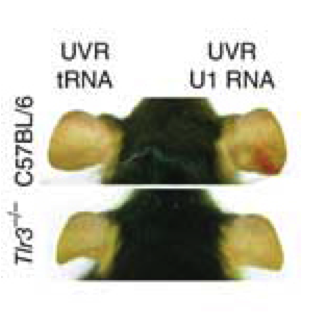
Mouse ears with U1-induced sunburn
Next, using a high throughput RNA sequencing approach, they found that there were changes in the structure of particular regions of snRNAs (non-coding RNAs involved in several nuclear processes, including mRNA splicing), and that these changes were likely candidates to activate ______ and produce the observed cytokine release. Sure enough, injection of UV-irradiated U1 snRNA induced “sunburn” in wild-type mice, but in ______ knockout mice the researchers saw no response.
These data open up a number of avenues for downstream applications, including the use of damage non-coding RNA as a biomarker for UV-induced damage and the development of alternatives to the phototherapeutic treatments used in several skin disorders.
Unfortunately, it would appear that the authors have no immediate plans to develop a super-sunscreen or anti-sunburn drug. I guess my fair-skinned compatriots and I will just have to stick to the old sunscreen and aloe combination for now.
.
Katie Pratt is a postdoc in Molecular Biology at Brown University. She has a passion for science communication, and in an attempt to bring hardcore biology and medicine to everyone, she blogs jargon-free at www.katiephd.com. Follow her escapades in the lab and online on Twitter.
.
Be the first one to mind the gap by filling in the missing gene as a comment and get your name in the blog along with a sweet new BenchFly mug!
.
UPDATE: Congratulations to Bryan Glezerson – this week’s Mind the Gap winner!
About the winner: Bryan is a researcher at the University of Calgary studying the microbiology of the cystic fibrosis lung. He’s particularly interested in mechanisms of Pseudomonas aeruginosa strain competition and “superinfection”.
About the prize: In addition to fame and glory beyond their wildest dreams, winners receive our new hot-off-the-presses large (15 oz) BenchFly mug to help quench their unending thirst for scientific knowledge… or coffee. Check out where the mug has traveled – will you be the first in your state or country to win one?
Miss a previous edition of Mind the Gap? Shame on you! Don’t worry – we’ve got you covered:
Let’s Talk About (Fruit Fly) Sex
This is Not an Article About Running Viruses
How is a Dormouse Like a Career Scientist?
With Great Power Comes Great Violin Strings
All the Better to See Sperm Whales With, My Dear
Saw VII: The Revenge of the Sawfish
Caution: Objects May Appear Larger Than They Really Are
Facebook Updates: The Good, The Bad, and The Vague
Scared of Dropping the Soap? Worry No More.
.
]]> The fruit fly Drosophila melanogaster has been the preferred model system for the study of numerous biological processes for decades, if not centuries. These little beasts are amenable to genetic manipulation, are relatively easy to keep in captivity, and have all sorts of physical traits that make them useful to scientists. Even though I work with frogs, I spend at least half my time reading about flies.
The fruit fly Drosophila melanogaster has been the preferred model system for the study of numerous biological processes for decades, if not centuries. These little beasts are amenable to genetic manipulation, are relatively easy to keep in captivity, and have all sorts of physical traits that make them useful to scientists. Even though I work with frogs, I spend at least half my time reading about flies.
But I don’t usually read about fruit fly sexy times, so today I made an exception, and read a paper about what lady Drosophila do after getting jiggy. It caught my eye mostly because one of the labs upstairs studies fruit fly courtship, so I’ve been lucky enough to watch many videos of these insects flirting. I was even introduced to the difficulty of trying to record them singing their mating songs over the hum of the building’s air conditioning. Just look at them go:
As you can see, it’s a fairly elaborate process. It’s also a highly orchestrated one, and the genes that control these behaviors have been very carefully mapped out. And here’s another part of Drosophila biology I love; the names of the genes. Doublesex, fruitless, pickpocket, Sex Peptide…OK so that last one is a bit lame. Anyway, these genes all interact in specific neuronal circuits to direct the courtship behaviors of both males and females.
After sex, however, these behaviors are markedly changed in the female fly. She no longer runs around coyly, looking back over her shoulder at the persistent male, and tapping her dainty feet provocatively. Instead, she puts all her efforts into laying her now fertilized eggs.
In a recent paper published in Current Biology, scientists from the Universities of Oxford and Glasgow and Harvard Medical School have shown on a molecular level how this post-mating behavior is controlled in the nervous system of the female fly. Genes previously implicated in courtship behavior, doublesex and fruitless, are expressed in neurons in the uterus. When the male ejaculates he deposits Sex Peptide along with his sperm. This small protein binds to receptors on the uterin neurons, which in turn relay a signal to the fly’s brain. Importantly, they then tracked the responses in the brain, and found that the mating signal was passed along to neuronal circuits controlling the physical aspects of egg-laying.
But what does this all mean?? It means that fruit flies are a fantastic model system for understanding the neural circuitry underlying complex behaviors (among many other things), and that Drosophila research will be a mainstay of biology departments the world over, no matter what Sarah Palin thinks.
.
Katie Pratt is a graduate student in Molecular Biology at Brown University. She has a passion for science communication, and in an attempt to bring hardcore biology and medicine to everyone, she blogs jargon-free at www.katiephd.com. Follow her escapades in the lab and online on Twitter.
.
Be the first one to mind the gap by filling in where the genes are expressed as a comment and get your name in the blog along with a sweet new BenchFly mug!
UPDATE! Congratulations to Ruben C – winner of this week’s Mind the Gap!
About the winner: Ruben is a geneticist at the University of Malta studying the role of RNA-binding proteins in neurodegeneration.
About the prize: In addition to fame and glory beyond their wildest dreams, winners receive our new hot-off-the-presses large (15 oz) BenchFly mug to help quench their unending thirst for scientific knowledge… or coffee. Check out where the mug has traveled – will you be the first in your state or country to win one?
Miss a previous edition of Mind the Gap? Shame on you! Don’t worry – we’ve got you covered:
This is Not an Article About Running Viruses
How is a Dormouse Like a Career Scientist?
With Great Power Comes Great Violin Strings
All the Better to See Sperm Whales With, My Dear
Saw VII: The Revenge of the Sawfish
Caution: Objects May Appear Larger Than They Really Are
Facebook Updates: The Good, The Bad, and The Vague
Scared of Dropping the Soap? Worry No More.
A Social Network for Food: Why Won’t Vanilla Friend Garlic?
I’d Rather Die Fat and Young than Old and Skinny
]]>
Just hook that little guy up to a generator, and boom! Electricity!
Sadly that’s not really how these scientists are making electricity from viruses. I mean, if I really think about it, there are several flaws to my idea: 1. How do you build a teeny tiny wheel? 2. How many teeny tiny wheels would you have to build to generate a sizeable amount of electricity? 3. How do you train the viruses to run on said teeny tiny wheels?
The way the authors of this Nature Nanotechnology paper did use their viruses, however, is pretty ingenious.
Their experiments were based on a phenomenon known as piezoelectric energy. This is the conversion of small amounts of mechanical energy, such as vibrations or strain, into electricity. For example, piezoelectric devices can harvest the vibrational energy produced by human footsteps if they are placed under a sidewalk. The amount of piezoelectricity generated is small, but there is potential for using it in small devices such as wristwatches and other hand-held devices. Harvesting this kind of energy relies on the specific physical and chemical properties of certain materials, and the major roadblocks to the widespread use of piezoelectric energy are the toxic chemicals needed to make these materials.
Enter biopiezoelectricity. There are several naturally occurring biomolecules that are known to possess piezoelectric energy generation potential. These include bone, collagen, and peptide nanotubes, all of which are inherently tricky to use. One of the key properties of a piezoelectric material is it needs to be organized into a regular, repeating, crystalline structure. Scientists have therefore been on the lookout for biological entities that naturally aggregate in this way. It is also important to be able to generate these molecules in large quantities; something that has also been an issue with previously characterized biopiezoelectric generators.
Lee and colleagues managed to overcome both of these problems by using a virus. The M13 bacteriophage (a virus that infects E. coli bacteria) is an 880nm-long rod-shaped particle that is made up of repeating protein building blocks called major coat proteins. These coat proteins self assemble, and the resulting rod has both rotational and screw symmetry, features that predispose a molecule to forming regular crystal sturctures. So what Byung Yang Lee and his pals at UC Berkeley did was to grow a large culture of E. coli in a liquid medium, infected the cells with M13, and let biology generate their starting materials for them. Then, they isolated the virus from the bacterial cells, and set about generating a structured crystal. But guess what? The viruses did that on their own too!
The researchers then set about testing this potentially piezoelectric material. They found that, with some genetic tweaking of the precise composition of the major coat protein, and by stacking the virus crystals into 7-layer deep arrays, they could generate up to 6 nano-Amps of current and 400 milli-volts of potential. Using this generator, they could power a small liquid crystal display, similar to those found in digital watches.
So, while this paper doesn’t describe the athletic properties of bacteriophage, it does provide a solution to the problems that have plagued the piezoelectricity field for some time. These self-assembling biomolecules could have direct real world applications in the not-too-distant future.
Piezoelectricity: Coming to an iPod near you soon!
.
Katie Pratt is a graduate student in Molecular Biology at Brown University. She has a passion for science communication, and in an attempt to bring hardcore biology and medicine to everyone, she blogs jargon-free at www.katiephd.com. Follow her escapades in the lab and online on Twitter.
.
Be the first one to mind the gap by filling in the bacteria name as a comment and get your name in the blog along with a sweet new BenchFly mug!
UPDATE – Congratulations to Michele Banks, winner of this week’s Mind the Gap!
About the winner: Michele Banks is a painter based in Washington, DC. Most of Banks’ artwork is inspired by science, particularly biology. Her work has been featured in The Scientist Online and Scientific American and has been exhibited at the National Institutes of Health. Check out her paintings and collages and follow her on Twitter.
About the prize: In addition to fame and glory beyond their wildest dreams, winners receive our new hot-off-the-presses large (15 oz) BenchFly mug to help quench their unending thirst for scientific knowledge… or coffee. Check out where the mug has traveled – will you be the first in your state or country to win one?
Miss a previous edition of Mind the Gap? Shame on you! Don’t worry – we’ve got you covered:
How is a Dormouse Like a Career Scientist?
With Great Power Comes Great Violin Strings
All the Better to See Sperm Whales With, My Dear
Saw VII: The Revenge of the Sawfish
Caution: Objects May Appear Larger Than They Really Are
Facebook Updates: The Good, The Bad, and The Vague
Scared of Dropping the Soap? Worry No More.
A Social Network for Food: Why Won’t Vanilla Friend Garlic?
I’d Rather Die Fat and Young than Old and Skinny
Look Into My Wide, Vacant, Eyes
Sweet Relief: How Sugar May Help Reverse Climate Change
]]>
 No it’s not predation by large owls, it’s strategic reproduction.
No it’s not predation by large owls, it’s strategic reproduction.
As anyone in academia knows, when to start a family is a really tricky decision. If you follow the traditional career path from college (4 years), to grad school (5-7 years), through a postdoc (3-6 years), perhaps another postdoc (3-6 years), into a tenure track position (5 years) which finally leads to a tenured faculty job (eternal) there really is no “good time” to pop out a baby or two.
After all, us mammals tend to reproduce at a time when we can ensure the survival of our offspring and ourselves, so we like to do so when there are plentiful supplies of food and water (and money), as well as reduced stresses such as predation or grant deadlines. While humans are not seasonal, the academic career is. There’s no way you want to have a baby while you prep for your qualifying exam, or get that paper submitted, or defend your thesis, or go on a gazillion post-doc interviews, or try to get that fellowship funded, or compete for tenure… Not to mention the fact that scientists have little to no financial security until they are tenured, a position few reach before the age of 40, at which point fertility can become a serious issue.
So what’s a baby-crazy scientist supposed to do?
In a recent paper published in Oecologia, Claudia Bieber and colleagues found that common dormice in Lithuania reproduce only once or twice a year, and the timing of these two litters was specific. The first peak in birth rate occurred in June, soon after the mice finished their hibernation period. Birth rate then dropped dramatically in July, only to rise again in late August, shortly before the mice returned to hibernation.
Having babies is a physical stress to the mother, but she in turn has to weigh her own discomfort against the survival of her offspring. Dormice often wait until their favorite diet of fruits and seeds are abundant in the late summer to have their first and only litter of pups. This allows the mother to fatten and provide rich and nutritious milk. It doesn’t, however, give her babies much chance to gain the fat stores they need to hibernate. On the other hand, if the mother can have her pups earlier in the year, she gives them a much greater chance of fattening up and surviving the winter.

Dormouse = Grad Student
But, as with all things in life, it gets more complicated than that when you take into account those pesky Tawny owls. In Lithuania, dormice make up almost 10% of their diet, thus posing a pretty serious threat to these little rodents. Indeed, dormouse life expectancy is much higher during hibernation than in the summer months, a factor that seems to play into the bimodal distribution of dormouse births; a pup born shortly before hibernation is much more likely to make it to sexual maturity than one born at the beginning of the active season.
So it is the balance between body mass and owl-attack-survival that appears to drive the reproductive strategy of the common dormouse. Is the same true for scientists?
In my cursory survey of the MCB department here at Brown, most people seem to have their babies while they’re post docs. While their job is temporary, the pay is better than a grad student stipend, and, in their late-twenties or early-thirties, it makes biological sense. So, if grad school and tenure track employment represent periods of hibernation, or sexual inactivity, then perhaps the postdoc represents a happy breeding season? A hypothesis to be tested, perhaps…
.
Katie Pratt is a graduate student in Molecular Biology at Brown University. She has a passion for science communication, and in an attempt to bring hardcore biology and medicine to everyone, she blogs jargon-free at www.katiephd.com. Follow her escapades in the lab and online on Twitter.
.
Be the first one to mind the gap by filling in the location as a comment and get your name in the blog along with a sweet new BenchFly mug!
UPDATE: Congratulations to Aaron – winner of this week’s Mind the Gap!
 About the winner: Aaron is a post-doctoral fellow at the University of Michigan studying brain circuits involved in food intake and metabolism. He’s also a self-professed running junky, an amateur nutritionist and a coffee addict. You can keep up with the latest from him on Twitter or Facebook.
About the winner: Aaron is a post-doctoral fellow at the University of Michigan studying brain circuits involved in food intake and metabolism. He’s also a self-professed running junky, an amateur nutritionist and a coffee addict. You can keep up with the latest from him on Twitter or Facebook.
About the prize: In addition to fame and glory beyond their wildest dreams, winners receive our new hot-off-the-presses large (15 oz) BenchFly mug to help quench their unending thirst for scientific knowledge… or coffee. Check out where the mug has traveled – will you be the first in your state or country to win one?
Miss a previous edition of Mind the Gap? Shame on you! Don’t worry – we’ve got you covered:
With Great Power Comes Great Violin Strings
All the Better to See Sperm Whales With, My Dear
Saw VII: The Revenge of the Sawfish
Caution: Objects May Appear Larger Than They Really Are
Facebook Updates: The Good, The Bad, and The Vague
Scared of Dropping the Soap? Worry No More.
A Social Network for Food: Why Won’t Vanilla Friend Garlic?
I’d Rather Die Fat and Young than Old and Skinny
Look Into My Wide, Vacant, Eyes
Sweet Relief: How Sugar May Help Reverse Climate Change
]]>
 As you may or may not know, I was a violinist well before I was a scientist. For some reason, teachers are much happier to put a violin into the hands of a six-year-old than they are a pipette or a beaker full of hydrochloric acid. Parents, on the other hand, are generally less impressed, especially when said six-year-old is encouraged to practice at home (a.k.a. impersonate a dying cat) for at least 20 minutes a day. But eventually I managed to make the tune of “Twinkle Twinkle Little Star “ discernable from the other strange sounds emanating from my violin, and I’ve been playing ever since.
As you may or may not know, I was a violinist well before I was a scientist. For some reason, teachers are much happier to put a violin into the hands of a six-year-old than they are a pipette or a beaker full of hydrochloric acid. Parents, on the other hand, are generally less impressed, especially when said six-year-old is encouraged to practice at home (a.k.a. impersonate a dying cat) for at least 20 minutes a day. But eventually I managed to make the tune of “Twinkle Twinkle Little Star “ discernable from the other strange sounds emanating from my violin, and I’ve been playing ever since.
“What does this have to do with science?” you ask. Not much. It does however explain why I found the following headline interesting:
Scientist fiddles with spider silk: Filaments are bundled, processed, and played on a violin. (ScienceNews.org)
Spider silk violin strings! Cool!
So I dug out the paper that was published this month in Physics Review Letters and sure enough, a scientist from Japan, Shigeyoshi Osaki, used spider silk to make violin strings.
There has been a lot of interest in using spider silk for various applications, including rope manufacturing and developing Kevlar-like fabrics that are exceedingly strong. Unfortunately a single spider doesn’t make that much silk, and housing a whole herd (I don’t think that’s the correct collective noun, but it conjures up a great visual) of spiders is more troublesome than you’d think, as they tend to eat each other, but there is a lot of work being done on the preparation of spider silk using molecular genetic techniques.
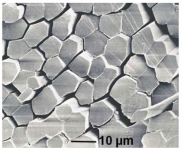
A cross section of the violin cable
In this instance, Osaki took spider silk from 300 female spiders (Nephila maculte), and arranged the 9,000 (for an A string) 3 feet-long strands in a parallel array. He then twisted the strands together to form a cable. This initial cable had lots of space between the strands, which would make it easily breakable, so he kept twisting and coated the strings with glycerol. When he looked at a cross-section of the resulting cable by electron microscopy he saw something surprising; the originally cylindrical silk strands had formed polyhedral shapes that fit together like crazy paving.
This in itself was a completely novel discovery in the world of spider silk research, and has the potential to change the way the material is used for other applications, but in the violin-string world there was still a crucial experiment left to do. Osaki needed to know if the strings sounded good.
So he manufactured a D string (12,000 strands) and a G string (15,000 strands) and assembled some professional violinists. He had them play either the Dancing Master’s Violin 1720 ‘‘Gillott’’ by Stradiviari (recognized as one of the best violins on the planet) or a run-of-the-mill violin strung with spider strings or conventional strings. While the professionals could perceive only a small difference on the Stradivarius, the spider strings made a vast improvement to the regular violin.
As to why these spider strings sound so great, Osaki suggests that “[t]he properties of spider violin strings can be ascribed to their elasticity, high modulus, and mechanically high strength that are characteristic of spider silk.” The timbre of the strings is affected also by their different and numerous overtones.
For the moment, spider violin strings are a novelty, and it will probably be a very long time before the likes of me get to string their violins with them. But we can search YouTube and find examples of them being played by others. Enjoy!
.
Katie Pratt is a graduate student in Molecular Biology at Brown University. She has a passion for science communication, and in an attempt to bring hardcore biology and medicine to everyone, she blogs jargon-free at www.katiephd.com. Follow her escapades in the lab and online on Twitter.
.
Be the first one to mind the gap by filling in the species of the spider as a comment and get your name in the blog along with a sweet new BenchFly mug!
About the prize: In addition to fame and glory beyond their wildest dreams, winners receive our new hot-off-the-presses large (15 oz) BenchFly mug to help quench their unending thirst for scientific knowledge… or coffee. Check out where the mug has traveled – will you be the first in your state or country to win one?
Miss a previous edition of Mind the Gap? Shame on you! Don’t worry – we’ve got you covered:
All the Better to See Sperm Whales With, My Dear
Saw VII: The Revenge of the Sawfish
Caution: Objects May Appear Larger Than They Really Are
Facebook Updates: The Good, The Bad, and The Vague
Scared of Dropping the Soap? Worry No More.
A Social Network for Food: Why Won’t Vanilla Friend Garlic?
I’d Rather Die Fat and Young than Old and Skinny
Look Into My Wide, Vacant, Eyes
Sweet Relief: How Sugar May Help Reverse Climate Change
]]>
 The other day I was talking to my parents via Skype when we were rudely interrupted by a very loud bird. It was a starling, and it was hanging out on the chimney, its (very loud) song echoing down into my parents’ living room.
The other day I was talking to my parents via Skype when we were rudely interrupted by a very loud bird. It was a starling, and it was hanging out on the chimney, its (very loud) song echoing down into my parents’ living room.
While we commented on the prettiness of the bird’s song, he was probably caught up in something more serious. Birds generally sing to attract a mate or to warn other birds of an intruder, not to entertain human beings. However while birdsong generally only has a positive impact on our day-to-day lives (except for the odd incident of an aggressive dawn chorus exacerbating a nasty hangover), humans have made the lives of urban birds a little tricky.
A recent study published in Animal Behaviour by David Luther and Elizabeth Derryberry looked at how human noise, particularly traffic noise, has affected the song of white-crowned sparrow in San Francisco. Male white-crowned sparrow generally learn one song, which they use throughout their whole life, and the song they learn depends on where they grew up. Much like a New Yorker will struggle to understand someone from the Deep South, a sparrow from the country will have trouble deciphering the warbling of a city sparrow. But what’s the difference?
Sound waves are defined both by their frequency, which determines pitch, and their amplitude, which determines volume. Anthropogenic noise, such as the sound of a car engine, tends to have a low frequency. Bird song is more varied, and utilizes sounds of both low and high frequency. In order to be heard above the surrounding cacophony of cars, a male urban sparrow would be therefore expected to either sing louder, or change his song so that it uses higher frequency sounds.
Luther and Derryberry used an archive of white-crowned sparrow recordings from different areas of San Francisco, spanning over 30 years, to address how these birds have adapted to life in the big city. Using these data, combined with an assessment of how noise in San Francisco has changed over the same time period, they found that the frequency of the sparrow song had indeed increased.
In their second experiment, the scientists took recordings of white-crowned sparrow from the 1970’s and played them back to sparrow in various parts of the city. The sparrow were far less interested in these songs than they were in songs from their contemporaries, suggesting they either couldn’t hear them as well over the ambient city sounds, or that they were less able to recognize them as local dialects.
In a similar study, Derryberry has looked at rural populations of the same birds and found that the frequency of the sparrow song had actually dropped, likely due to the preference of female sparrow for these more sultry tones.
And this is what Luther and Derryberry plan to address next, but when they’re done perhaps they could assess the acoustic advantage of singing atop a chimney by starlings in rural areas of northern England…
.
Katie Pratt is a graduate student in Molecular Biology at Brown University. She has a passion for science communication, and in an attempt to bring hardcore biology and medicine to everyone, she blogs jargon-free at www.katiephd.com. Follow her escapades in the lab and online on Twitter.
.
Be the first one to mind the gap by filling in the type of bird as a comment and get your name in the blog along with a sweet new BenchFly mug!
UPDATE! Congratulations to Jason – this week’s winner of Mind the Gap!
About the winner: Jason is an immunologist focused on HIV research. Follow him on Twitter for his latest thoughts.
About the prize: In addition to fame and glory beyond their wildest dreams, winners receive our new hot-off-the-presses large (15 oz) BenchFly mug to help quench their unending thirst for scientific knowledge… or coffee. Check out where the mug has traveled – will you be the first in your state or country to win one?
Miss a previous edition of Mind the Gap? Shame on you! Don’t worry – we’ve got you covered:
All the Better to See Sperm Whales With, My Dear
Saw VII: The Revenge of the Sawfish
Caution: Objects May Appear Larger Than They Really Are
Facebook Updates: The Good, The Bad, and The Vague
Scared of Dropping the Soap? Worry No More.
A Social Network for Food: Why Won’t Vanilla Friend Garlic?
I’d Rather Die Fat and Young than Old and Skinny
Look Into My Wide, Vacant, Eyes
Sweet Relief: How Sugar May Help Reverse Climate Change
.
.
]]> The colossal squid has the largest eyes on the planet, but it remains a mystery as to why. These soccer ball-sized eyes are almost three times the size of the second largest animal eyes (those of the sperm whale reach 109mm in diameter), and up until now they were thought to have a diameter of 250 to 400mm. However studying them has proved challenging, as these underwater giants are extremely elusive.
The colossal squid has the largest eyes on the planet, but it remains a mystery as to why. These soccer ball-sized eyes are almost three times the size of the second largest animal eyes (those of the sperm whale reach 109mm in diameter), and up until now they were thought to have a diameter of 250 to 400mm. However studying them has proved challenging, as these underwater giants are extremely elusive.
Animal eyes are uniquely adapted to the lives of their owners. For example, birds of prey have eyes that can spot small rodents moving as they soar hundreds of feet above them. Grazing animals, however, have excellent peripheral vision and have their eyes positioned on the sides of their heads in order to increase their field of vision and watch out for predators.
But in no other animal than the squid does this adaptation result in a gargantuan eyeball.
A new paper published this month in Current Biology postulates a new theory that might underscore the evolution of this huge organ. Researchers at Lund University, Sweden, and Duke University, North Carolina, began their research by trying to find an accurate measurement of a squid eyeball. They dug up a photograph from 1981 that showed a freshly caught squid with a pupil that measured 90mm in diameter. They also took a direct measurement of the eye of a squid captured in New Zealand, which had a diameter of 270mm. That’s bigger than a human head!
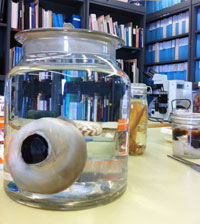
You seen my body anywhere?
The team then used various modeling approaches to test the situations in which this eye might perform well in an effort to find the selection pressure that drove its development. They took into account the fact that these animals live in deep water where there is little or no sunlight, and also the refractive properties of water. They found that while certain properties, such as hunting for small prey, were not aided by a large eye, the ability to spot large objects would be enhanced.
So what large objects would a colossal squid need to spot?
Sperm whales. They like to eat squid, and unlike other whale-bait, giant and colossal squid actually possess enough speed to elude these large predators. But wait…wouldn’t it be too dark to see a sperm whale? Yes, but the squid likely aren’t looking directly at the whale but at the bioluminescence (generated by a number of species of plankton) it disturbs as it approaches.
Sadly this is where the theory falls apart a little, as it would only account for this eye-adaption if colossal squid were usually found inhabiting plankton-rich waters. And even if they were, how would they know the plankton were there without a large animal to disturb them? The authors suggest that perhaps squid are attracted to the plankton for some other reason, such as to find a mate, but that’s unfortunately where the speculation ends.
One thing’s for sure, though; a giant squid would look far more terrifying in grandma’s nightgown than a wolf. Tentacles everywhere.
.
Katie Pratt is a graduate student in Molecular Biology at Brown University. She has a passion for science communication, and in an attempt to bring hardcore biology and medicine to everyone, she blogs jargon-free at www.katiephd.com. Follow her escapades in the lab and online on Twitter.
.
Be the first one to mind the gap by filling in the size of the squid eyeball (+/- 10mm) as a comment and get your name in the blog along with a sweet new BenchFly mug!
 UPDATE: Congratulations to Veena Thomas – winner of this week’s Mind the Gap!
UPDATE: Congratulations to Veena Thomas – winner of this week’s Mind the Gap!
About the winner: Dr. Veena Thomas is a postdoctoral fellow in Vijay Pande’s lab at Stanford University. Her research interests include computational simulations of protein aggregation diseases, for which she was awarded an NRSA fellowship, and ligand-based drug design for neglected diseases.
.
About the prize: In addition to fame and glory beyond their wildest dreams, winners receive our new hot-off-the-presses large (15 oz) BenchFly mug to help quench their unending thirst for scientific knowledge… or coffee. Check out where the mug has traveled – will you be the first in your state or country to win one?
Miss a previous edition of Mind the Gap? Shame on you! Don’t worry – we’ve got you covered:
Saw VII: The Revenge of the Sawfish
Caution: Objects May Appear Larger Than They Really Are
Facebook Updates: The Good, The Bad, and The Vague
Scared of Dropping the Soap? Worry No More.
A Social Network for Food: Why Won’t Vanilla Friend Garlic?
I’d Rather Die Fat and Young than Old and Skinny
Look Into My Wide, Vacant, Eyes
Sweet Relief: How Sugar May Help Reverse Climate Change
Laughter Really is the Best Medicine
All Work and No Play Makes Katie RSI Prone
Sexual Identity and Autocrine Stimulation: Oh, To Be Teenage Yeast
On Wine, Sunburns and the Tendency of Headlines to Mislead
Which Came First: The Opossum or the Snake?
Pigeons Know a Crazy Woman When they See One
To Boldly Go Where No Worm Has Gone Before
Another One Bites the Dust: Rinderpest Eradicated
Scientists Just Wanna Have Fun (Like Uncaged Monkeys)
Mosquitoes Eating You Alive? Cheesy Feet Could be the Problem
.
.
]]>